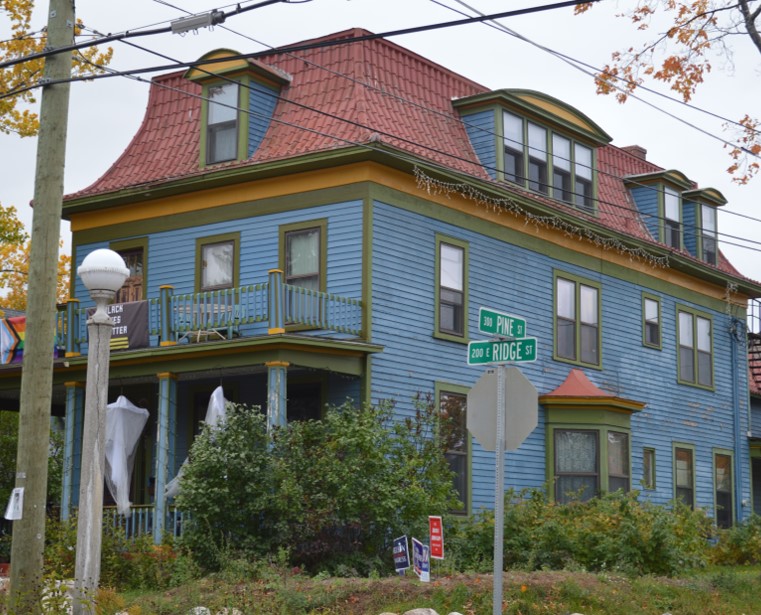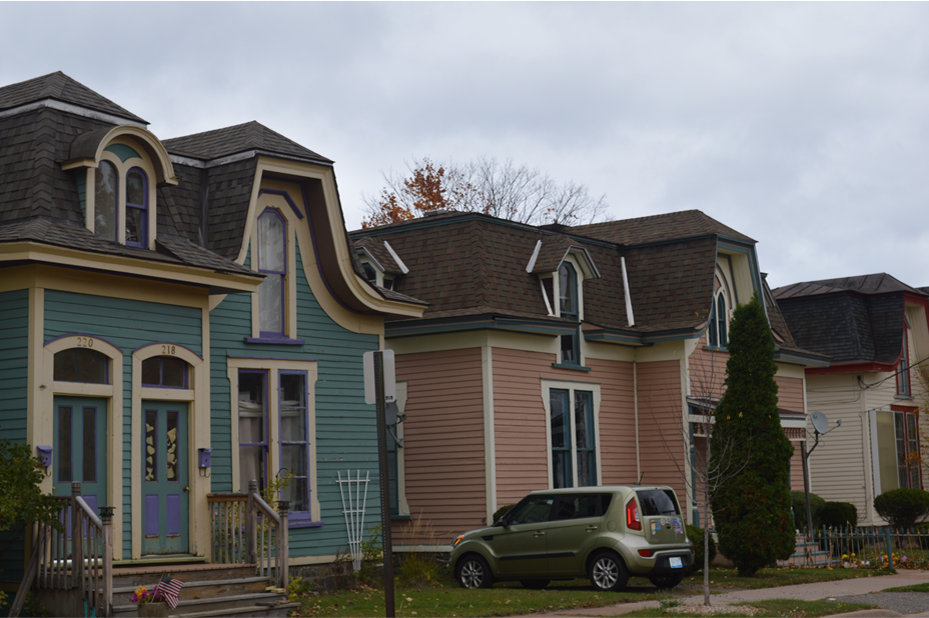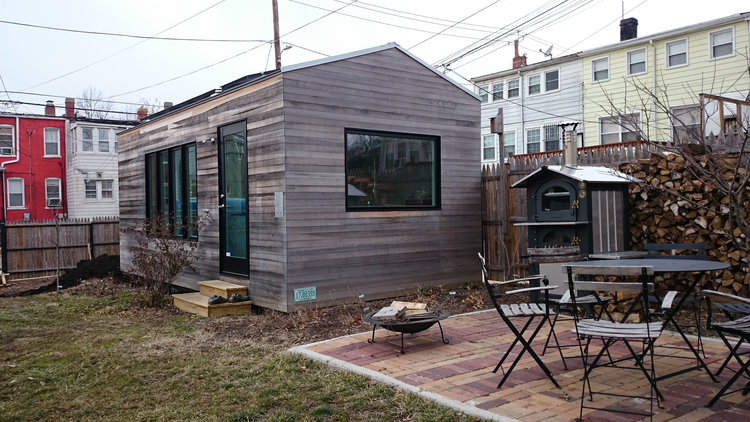DISCLAIMER: This blog is written by Marquette City Commissioner Evan Bonsall, who also serves as the Chair of the City of Marquette Ad Hoc Housing Committee. The views expressed in this blog are his own, and do not represent the views or imply the official endorsement of the Ad Hoc Housing Committee, the Marquette City Commission, or any of the individual members of the Ad Hoc Housing Committee or City Commission.
Q: What is Missing Middle Housing?
A: Missing Middle Housing is one of the most important terms to know when it comes to housing affordability. It was coined in 2010 by Dan Parolek, a world-renowned architect and planner (i) – in fact, the Housing Committee was fortunate enough to have Mr. Parolek himself present about Missing Middle Housing at our Dec. 6, 2020 meeting. (ii) Missing Middle Housing generally has two definitions:
1) Housing that is affordable for middle-income families (including those in the “workforce housing” range of 80-120% Area Median Income that we discussed in the last housing blog post), and
2) Housing that falls somewhere in between a large single-family home and a large apartment complex in terms of scale and form. (iii)
These definitions are interrelated – Missing Middle Housing types generally produce smaller, more affordable housing units, and a shortage of Missing Middle Housing is making it harder for middle-income households to find affordable housing in Marquette and many other communities. (iv) But what does the Housing Committee’s Initial Report say about Missing Middle Housing?
For starters, the Housing Committee included Dan Parolek’s definition of Missing Middle Housing in the Initial Report – it reads as follows:
“A range of house-scale buildings with multiple units – compatible in scale and form with detached single-family homes – located in a walkable neighborhood.” (v)
This is a very profound definition, and the point about “house-scale buildings” is especially important – we are not talking about giant, ugly apartment buildings, but buildings that could fit right into existing neighborhoods in Marquette. In fact, as Mr. Parolek noted during his presentation (and as Housing Committee member Antonio Adan and I pointed out in an earlier presentation to the Committee that was included in the Initial Report), Marquette already has many great examples of Missing Middle Housing, especially in our historic neighborhoods in east and central Marquette. (vi, vii)

Just take a walk down Pine Street or Ridge Street, and you will see everything from Victorian mansions to small apartment buildings with 2-to-4 units. In fact, these are often one in the same – I live in an affordable fourplex that was once an expensive Victorian mansion owned by a single wealthy family, but which is now home to 4 different low-to-middle-income households. There’s an affordable duplex next door, a huge Victorian mansion across the street, and a more modest, affordable single-family home on the same block. This pattern is repeated throughout the neighborhood, yet this is still one of the most desirable places to live in Marquette, property values are strong, there is adequate parking, and most homes are well-maintained. If more neighborhoods were like this in Marquette, City residents would have a much wider array of housing choices to meet their needs, and housing would be more affordable.

Mr. Parolek’s planning and design firm, Opticos Design, has created an award-winning website about Missing Middle Housing, which goes through the wide range of potential Missing Middle Housing types. (viii) The excellent image below also provides a great, easy-to-understand visual representation of the various Missing Middle Housing types. (ix)

As you can see, Missing Middle Housing types include duplexes, Accessory Dwelling Units (a.k.a., ADUs or “granny flats”), cottage courts and courtyard apartments, townhomes, upper-level apartments in mixed-use buildings, triplexes, fourplexes, etc. (x, xi) There also seemed to be a consensus among the Housing Committee members that, at least for our purposes here in Marquette, it made sense to consider small single-family homes to be a type of Missing Middle Housing as well.

These different types of Missing Middle Housing can all work in different contexts, and they aren’t all a good fit for every neighborhood, but by legalizing more types of Missing Middle Housing in our zoning code and encouraging Missing Middle Housing development, over time the City of Marquette can gradually but significantly increase the supply of housing that falls in the “workforce housing” price range and which meets the evolving housing needs of Marquette residents. Speaking of which…
Q: Who is Missing Middle Housing for?
A: As Antonio Adan and I noted in our presentation to the Housing Committee in October 2020, expanding Marquette’s supply of Missing Middle Housing can help meet the housing needs of many City residents. (xii) For example, Missing Middle Housing can be great for NMU students, who often struggle to find decent, affordable apartments in Marquette. It’s also great for young professionals (including young couples), who are often working lower-paying entry-level jobs and who frequently prefer to live near services and amenities. Many Missing Middle Housing types can also provide adequate affordability and space for young families with children.
And it’s not just young people who could benefit from more Missing Middle Housing in Marquette. As Antonio and I noted in our presentation to the Housing Committee and as Mr. Parolek and Arthur C. Nelson explain in their recent book, Missing Middle Housing can also help meet the needs of seniors by providing housing that is affordable for retirees on fixed incomes, and modest-sized units that are perfect for seniors looking to downsize. (xiii) And because Missing Middle Housing works best when it is located in walkable neighborhoods, it is also a great option for seniors with limited physical mobility or who may be unable to drive, who need to live in accessible, affordable housing that’s within easy walking distance of vital services. (xiv) This is why the AARP strongly supports Missing Middle Housing and zoning reform in both rural and urban communities. (xv, xvi)
In fact, the City’s 2004 and 2015 Community Master Plans both identified a need for more “higher-density housing for mature households (55+) years in close proximity to downtown and established neighborhoods” in Marquette. (xvii) Both Master Plans were based on a large amount of community input going back to 2003, so it’s clear that between the evolving housing needs of the Millennials and those of the Baby Boomers, a need for more affordable, accessible Missing Middle Housing has existed in Marquette for many years.
Finally, lest you think that the Housing Committee is only concerned about renters, Missing Middle Housing is for homeowners, too. Smaller single-family homes, townhomes, cottage courts, and so on are all types of Missing Middle Housing that are often owner-occupied. ADUs can also provide a source of much-needed supplemental income for homeowners, and landlords often occupy one of the units in the duplexes, triplexes, or fourplexes that they own – in fact, my landlords live in one of the units in my fourplex.

Q: How does the Housing Committee recommend that we create more Missing Middle Housing in Marquette?
A: There are several recommendations in the Housing Committee’s Initial Report that are related directly to Missing Middle Housing, which were all unanimously approved by the Housing Committee in January 2021. (xviii) Here they are, in the order that they appear in the Initial Report:
1) “Allow Accessory Dwelling Units and Duplex Units as a Permitted Use.” (xix)
The Housing Committee determined that duplexes and Accessory Dwelling Units (ADUs, a.k.a. “granny flats”) were Missing Middle Housing types that were low-impact and very similar in scale to single-family homes, and that as a result they would be a good fit in any neighborhood in Marquette. I’m sure we’re all familiar with duplexes, and we will discuss ADUs in greater detail in a future blog post – they are essentially small housing units of less than 1,000 square feet which can be built in backyards or on top of garages on the same property as an existing single-family home. (xx) In the meantime, if you’re curious about ADUs, I would encourage you to check out this article by Strong Towns. (xxi)
The Housing Committee recommends that duplexes and ADUs should be made a “permitted use” in all residential zoning districts in the City of Marquette – in other words, you should be able to build a duplex or an ADU in any neighborhood in Marquette without going through a lengthy, complicated Special Land Use permitting process. (xxii) After all, why should a special public hearing and a vote by the entire Planning Commission be necessary just to put an ADU in your backyard? Allowing duplexes and ADUs as permitted uses across the City was also recommended by many of the expert sources the Housing Committee consulted, including Mr. Parolek, (xxiii) David Allen (a former City Commissioner and housing expert from Grand Rapids), (xxiv), Central Upper Peninsula Planning and Development (CUPPAD), (xxv) and a report on small-town housing affordability released in 2020 by the Congress for the New Urbanism (CNU) and the State of Vermont. (xxvi)
Of course, not all types of Missing Middle Housing make sense in every neighborhood. Mr. Parolek advised that while in his view the ideal Missing Middle Housing type is the fourplex, “the ideal places for development of these units are neighborhoods adjacent to downtown, as those are transition areas.” (xxvii) In our Initial Report, the Housing Commission did not include any recommendations regarding triplexes, fourplexes, cottage courts, or other types of Missing Middle Housing besides duplexes and ADUs. There will likely be more information and recommendations about Missing Middle Housing in the Housing Committee’s Final Report in June 2021.

2) “Adjust lot size requirements to accommodate duplexes.” (xxviii)
The City imposes lot size and setback requirements on all residential buildings, and the idea behind this recommendation is that there is not really any good reason why duplexes should be treated differently than single-family homes when it comes to these lot size requirements. And yet, under the current City zoning regulations, lots that contain duplexes must have double the minimum side yard setback (10 ft. instead of 5 ft.), must be 33%-100% wider (50-75 ft. instead of 37.5 ft.), and must be 33%-100% larger by area (6,000-9,000 sq. ft. instead of 4,500 sq. ft.) than lots containing single-family homes. (xxix)
These lot size requirements do not make much logical sense, and they often make it very difficult or even impossible to develop duplexes on small lots, severely limiting Marquette’s supply of Missing Middle Housing. In fact, at our last meeting the Housing Committee was informed that a small developer who recently purchased several lots south of the old hospital property is struggling to site the affordable single-family homes and duplexes they want to develop on those lots due to lot size requirements. (xxx) Reducing required lot sizes for duplexes to be similar to those for single-family homes would make duplexes much easier and less expensive to develop in Marquette, and would not have any foreseeable negative impacts on Marquette neighborhoods.
3) “Relax minimum parking requirements for multi-family developments where appropriate.” (xxxi)
Mr. Parolek noted in his presentation that “parking requirements are a hindrance” to Missing Middle Housing development in many cases. (xxxii) Off-street parking requirements are an important part of the City zoning code, especially given the fact that Marquette receives a lot of snow and prohibits overnight on-street parking during the winter. However, that does not mean that the City’s current minimum off-street parking requirements necessarily make sense, or that they cannot be sensibly reduced to facilitate more Missing Middle Housing development. The specifics of any parking policy changes will be left up to the City of Marquette Planning Commission – in fact, they are already working diligently on this issue – and ultimately will need to be approved by the City Commission after public review and at least two public hearings.
Final Thoughts
Before I wrap up this blog, I want to reiterate that the Housing Committee has only released our Initial Report – this is really just a polished draft, which you can read for yourself HERE. There will be much more detailed information and many more recommendations in the Final Report when it is approved by the Housing Committee in June 2021. It is also important to remember that even the Final Report will not include any mandates or final decisions, but merely policy recommendations, as the Housing Committee is a temporary City advisory board and does not have the power to make policy. That power ultimately lies with the City Commission alone.
If you have any questions, concerns, or ideas about the Housing Committee’s Initial Report, suggestions for the Final Report, or any special knowledge or experience that you would like to share with the Committee, please reach out to me at [email protected] or (906) 236-0247. And don’t forget to check back here and on my Facebook page at www.facebook.com/evanbonsall4mqt for future housing-related blog posts – I realize that it has been a couple of weeks since the last one, and I plan to post one or two each week moving forward until all the FAQs have been answered!
Sources
(i) “What Is Missing Middle Housing?” missingmiddlehousing.com, Opticos Design, 2019.
(ii) “City of Marquette Ad-Hoc Housing Committee Initial Report of Findings.” Ad Hoc Housing Committee, City of Marquette. 15 January 2021. Appendix A: Meeting Minutes, “Official Proceedings of the Marquette Ad Hoc Housing Committee, December 6, 2020,” p. 1-2.
(iii) Same as previous two citations.
(iv) “City of Marquette Ad-Hoc Housing Committee Initial Report of Findings.” Ad Hoc Housing Committee, City of Marquette. 15 January 2021. Appendix A: Meeting Minutes, “Official Proceedings of the Marquette Ad Hoc Housing Committee, December 6, 2020,” p. 1-2.
(v) “City of Marquette Ad-Hoc Housing Committee Initial Report of Findings.” Ad Hoc Housing Committee, City of Marquette. 15 January 2021, pp. 6.
(vi) “City of Marquette Ad-Hoc Housing Committee Initial Report of Findings.” Ad Hoc Housing Committee, City of Marquette. 15 January 2021. Appendix A: Meeting Minutes, “Official Proceedings of the Marquette Ad Hoc Housing Committee, December 6, 2020,” p. 1.
(vii) “City of Marquette Ad-Hoc Housing Committee Initial Report of Findings.” Ad Hoc Housing Committee, City of Marquette. 15 January 2021. Appendix E: Missing Middle Marquette Walking Tour, presentation by Adan, Antonio and Evan Bonsall, October 13, 2020.
(viii) missingmiddlehousing.com, Opticos Design, 2019.
(ix) “Missing Middle Housing Diagram.” Dan Parolek, Opticos Design, 2020.
(x) “The Types.” missingmiddlehousing.com, Opticos Design, 2019.
(xii) City of Marquette Ad-Hoc Housing Committee Initial Report of Findings.” Ad Hoc Housing Committee, City of Marquette. 15 January 2021. Appendix E: Missing Middle Marquette Walking Tour, presentation by Antonio Adan and Evan Bonsall, October 13, 2020.
(xiii) “Missing Middle Housing: Thinking Big and Building Small to Respond to Today’s Housing Crisis.” Parolek, Daniel and Arthur C. Nelson. Island Press, 2020.
(xiv) “What Is Missing Middle Housing?” missingmiddlehousing.com, Opticos Design, 2019.
(xv) “Bring Back Missing Middle Housing.” AARP, 2019. https://www.aarp.org/livable-communities/housing/info-2019/bring-back-missing-middle-housing.html
(xvi) “Where We Live: Communities for All Ages, 2018 Edition.” LeaMond, Nancy. AARP, 2018.
(xvii) “City of Marquette Community Master Plan: A Superior Vision for Marquette.” City of Marquette, Aug. 11, 2015, pp. 2-2.
(xviii) “City of Marquette Ad-Hoc Housing Committee Initial Report of Findings.” Ad Hoc Housing Committee, City of Marquette. 15 January 2021. Appendix A: Meeting Minutes, “Official Proceedings of the Marquette Ad Hoc Housing Committee, January 14, 2020.”
(xx) “A couple built an apartment above their garage. Ann Arbor officials want more like it.” Stanton, Ryan. MLive.com. 01 March 2021.
(xxi) “Strength Test #4: Are accessory dwelling units allowed in your town?” Quednau, Rachel. Strong Towns. 16 August 2017.
(xxii) “City of Marquette Ad-Hoc Housing Committee Initial Report of Findings.” Ad Hoc Housing Committee, City of Marquette. 15 January 2021, pp. 6.
(xxiii) “City of Marquette Ad-Hoc Housing Committee Initial Report of Findings.” Ad Hoc Housing Committee, City of Marquette. 15 January 2021. Appendix A: Meeting Minutes, “Official Proceedings of the Marquette Ad Hoc Housing Committee, December 6, 2020,” p. 1-2.
(xxiv) “City of Marquette Ad-Hoc Housing Committee Initial Report of Findings.” Ad Hoc Housing Committee, City of Marquette. 15 January 2021, pp. 6.
(xxv) “City of Marquette Ad-Hoc Housing Committee Initial Report of Findings.” Ad Hoc Housing Committee, City of Marquette. 15 January 2021. Appendix C: CUPPAD Marquette County Housing Market Assessment, December 2020, pp. 5.
(xxvi) “Enabling Better Places: A Zoning Guide for Vermont Neighborhoods.” Vermont Agency of Commerce and Community Development and the Congress for the New Urbanism. August 2020.
(xxvii) “City of Marquette Ad-Hoc Housing Committee Initial Report of Findings.” Ad Hoc Housing Committee, City of Marquette. 15 January 2021, pp. 6-7.
(xxviii) “City of Marquette Ad-Hoc Housing Committee Initial Report of Findings.” Ad Hoc Housing Committee, City of Marquette. 15 January 2021, pp. 9.
(xxix) City of Marquette Land Development Code, Section 54.403: Footnotes to Schedule of Regulations, Subsections C & D, pp. 4-2.
(xxx) City of Marquette Ad Hoc Housing Committee Meeting, 9 February 2021.
(xxxi) “City of Marquette Ad-Hoc Housing Committee Initial Report of Findings.” Ad Hoc Housing Committee, City of Marquette. 15 January 2021, pp. 9.
(xxxii) “City of Marquette Ad-Hoc Housing Committee Initial Report of Findings.” Ad Hoc Housing Committee, City of Marquette. 15 January 2021. Appendix A: Meeting Minutes, “Official Proceedings of the Marquette Ad Hoc Housing Committee, December 6, 2020,” p. 1.







